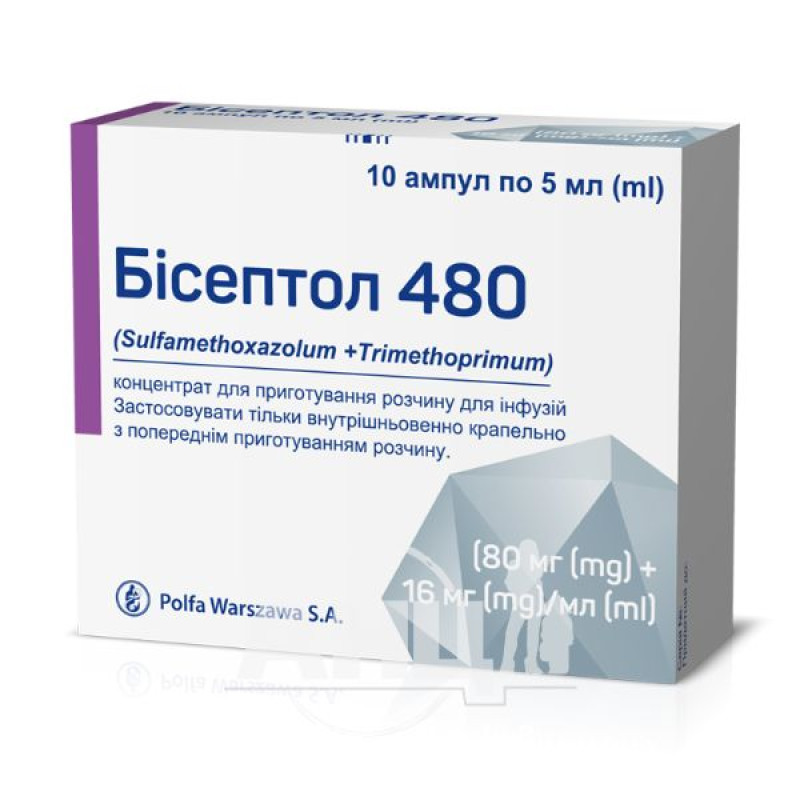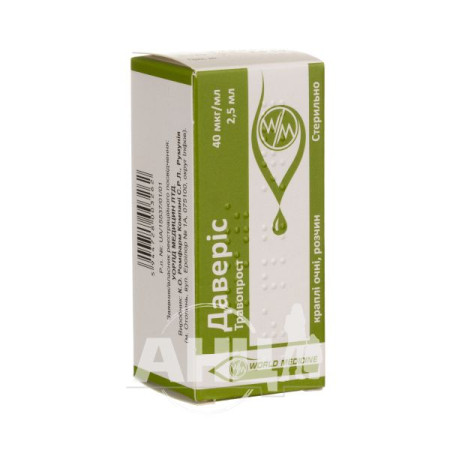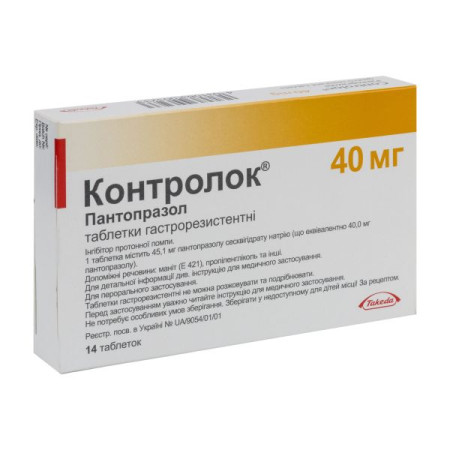Biseptol 480 concentrate for solution for infusions 480 mg/5 ml ampoule 5 ml No. 10

Biseptol 480 is an antibacterial drug containing two active substances - sulfamethoxazole and trimethoprim.
Trimethoprim is excreted mainly by the kidneys, and approximately 50% is excreted unchanged in the urine within 24 hours. Several metabolites of trimethoprim have been identified in the urine. Sulfamethoxazole is a weak acid with a pKa = 6.0. The concentration of the active form of sulfamethoxazole in amniotic fluid, bile, cerebrospinal fluid, middle ear secretion, sputum, synovial fluid, intracellular fluid is from 20% to 50% of sulfamethoxazole found in blood plasma.
Approximately 66% of sulfamethoxazole is bound to plasma proteins. The half-life in subjects with normal renal function is 9 to 11 hours. In subjects with impaired renal function, no change in the half-life of the active form of sulfamethoxazole has been established, but the half-life of the main acetylated metabolite is prolonged if creatinine clearance is less than 25 ml/min.
Sulfamethoxazole is excreted primarily by the kidneys, with 15% to 30% of the administered dose being found in the urine in the active form. Elderly patients have a reduced renal clearance of sulfamethoxazole.
Indications for use
The indications for cotrimoxazole in the form of a concentrate for the preparation of a solution for infusion are the same as for oral forms.
Urinary tract infections: treatment of severe uncomplicated urinary tract infections (in the initial stages of uncomplicated urinary tract infections, it is recommended to give preference to the use of an effective monodrug compared to combination treatment), treatment and prevention of pneumonia caused by P. jiroveci (formerly P. sarini) (PCP), treatment and prevention of toxoplasmosis.Contraindication
Hypersensitivity to the active substances, to sulfonamides or trimethoprim or to any of the excipients. Severe parenchymal liver disease. Severe renal impairment (creatinine clearance <15 ml/min) if it is not possible to periodically determine the concentration of trimethoprim and sulfamethoxazole in the blood plasma. Megaloblastic anemia due to folate deficiency. Immune thrombocytopenia caused by the use of trimethoprim and/or sulfonamides. Hematological disorders. Combination with dofetilide. Glucose-6-phosphate dehydrogenase deficiency. Age during the first 6 weeks of life and premature infants, except for the prevention of PCP in infants from 4 weeks of age.Method of administration and doses
Biseptol 480, concentrate for solution for infusion, is intended for intravenous administration only. Dilute before use.
Biseptol 480 must be diluted immediately before use. When mixing Biseptol 480 with infusion solutions, the resulting mixture must be shaken vigorously to mix thoroughly. If a precipitate is detected or crystals appear in the diluted concentrate, it should be discarded and a new infusion prepared. The following scheme for diluting Biseptol 480 is recommended:
1 ampoule (5 ml) of Biseptol 480 in 125 ml of solution for infusions; 2 ampoules (10 ml) of Biseptol 480 in 250 ml of solution for infusions; 3 ampoules (15 ml) of Biseptol 480 in 500 ml of solution for infusions.To dilute Biseptol 480, use the following infusion solutions:
5% and 10% glucose solution 0.9% sodium chloride solution Ringer's solution; 0.45% sodium chloride solution with 2.5% glucose solution.Do not use other solutions for diluting Biseptol 480, except those mentioned above.
The prepared solution of the drug cannot be mixed with other medicines.
The infusion of the drug should last approximately 60-90 minutes and depends on the degree of hydration of the patient.
If the patient is contraindicated in the administration of large amounts of fluid, a higher concentration of cotrimoxazole is allowed - 5 ml in 75 ml of 5% glucose. The finished solution of the drug should be administered over no more than 1 hour.
Unused solution should be discarded.
Overdose
The maximum dose tolerated by humans is unknown. Symptoms of acute overdose: nausea, vomiting, diarrhea, colic, headache, vertigo, dizziness, drowsiness, loss of consciousness, confusion, fever, intellectual and visual disorders, jaundice, blood disorders, in severe cases - crystalluria, hematuria and anuria.
Symptoms of chronic overdose: inhibition of hematopoiesis (thrombocytopenia, leukopenia, megaloblastic anemia), as well as other pathological changes in the blood picture due to folic acid deficiency.
Treatment. In case of established, suspected or accidental overdose, the drug should be discontinued immediately. Increased renal excretion by forced diuresis (urine alkalinization promotes the excretion of sulfamethoxazole), hemodialysis (peritoneal dialysis is ineffective). It is necessary to monitor the blood picture and electrolyte levels. In case of pronounced pathological changes in the blood picture or jaundice, specific treatment should be prescribed. To eliminate the effect of trimethoprim on hematopoiesis, calcium folinate can be prescribed at a dose of 3-6 mg for 5-7 days.
Special instructions
Use during pregnancy or breastfeeding
There are no reliable data on the use of co-trimoxazole in pregnant women. Studies have shown a possible association between the action of folic acid antagonists and the development of fetal damage. Trimethoprim is a folic acid antagonist, in animal studies, both active substances caused fetal abnormalities.
Co-trimoxazole should not be used during pregnancy, especially in the first trimester, unless clearly necessary. If necessary, pregnant women should consider taking folic acid.
Sulfamethoxazole competes with bilirubin for the binding site of plasma albumin. If the drug is administered to the mother immediately before delivery, significant concentrations of the drug derived from the mother remain in the newborn for several days, and there is a risk of bilirubin precipitation or increased hyperbilirubinemia, which is theoretically associated with the risk of kernicterus. This is especially true for newborns at increased risk of hyperbilirubinemia, especially premature infants and infants with glucose-6-phosphate dehydrogenase deficiency.
Breastfeeding.
Since trimethoprim and sulfamethoxazole pass into breast milk, breastfeeding while taking Biseptol 480 is not recommended, especially for infants with hyperbilirubinemia or at risk of developing it.
In addition, co-trimoxazole should be avoided in neonates younger than 8 weeks of age due to the susceptibility to neonatal hyperbilirubinemia.
Children
Use in children from 6 weeks of age.
Ability to influence reaction speed when driving vehicles or other mechanisms
Biseptol 480 usually has no direct effect on the ability to drive or use machines. However, there is a possibility of side effects from the nervous system and psyche that may affect this ability, in some cases to a significant extent.
Composition
active ingredients: sulfamethoxazole, trimethoprim;
1 ml of concentrate contains sulfamethoxazole 80 mg, trimethoprim 16 mg
Excipients: propylene glycol, ethanol 96%, benzyl alcohol, sodium metabisulfite (E 223), sodium hydroxide, sodium hydroxide 10%, water for injections
1 ampoule (5 ml of concentrate) contains sulfamethoxazole 400 mg and trimethoprim 80 mg.
Storage conditions
Store in the original packaging at a temperature not exceeding 25 °C. Do not freeze.
Keep out of reach of children.
Shelf life - 5 years.
Do not use after the expiration date.
There are no reviews for this product.
There are no reviews for this product, be the first to leave your review.
No questions about this product, be the first and ask your question.








